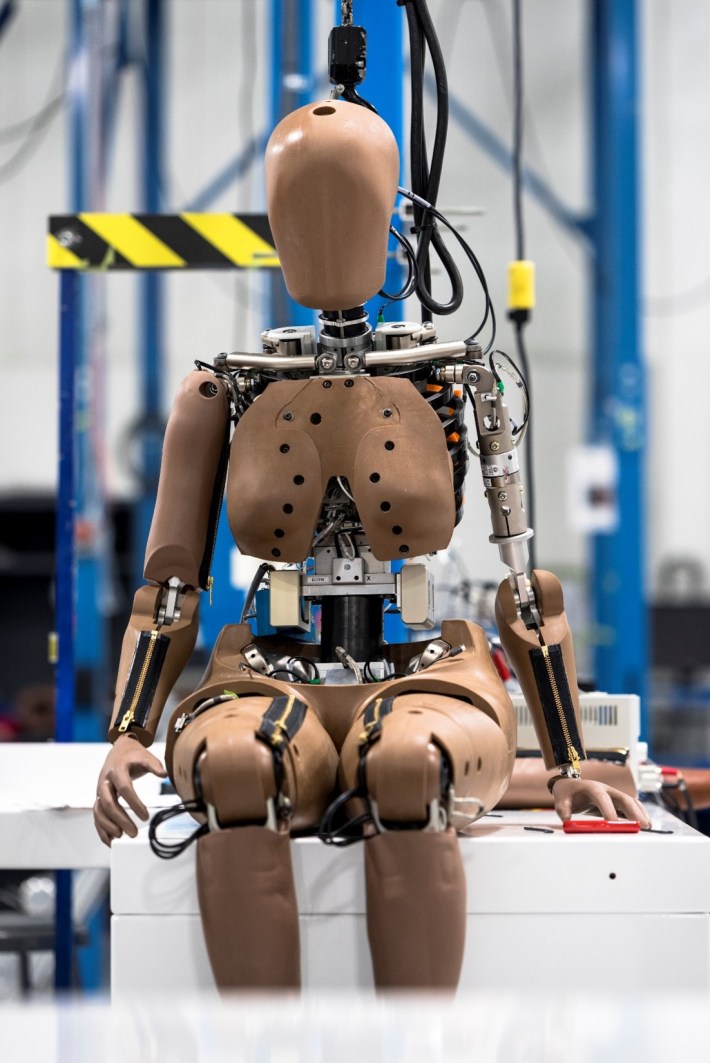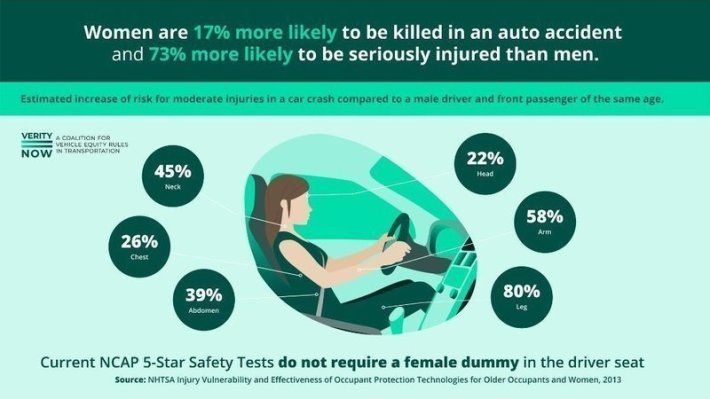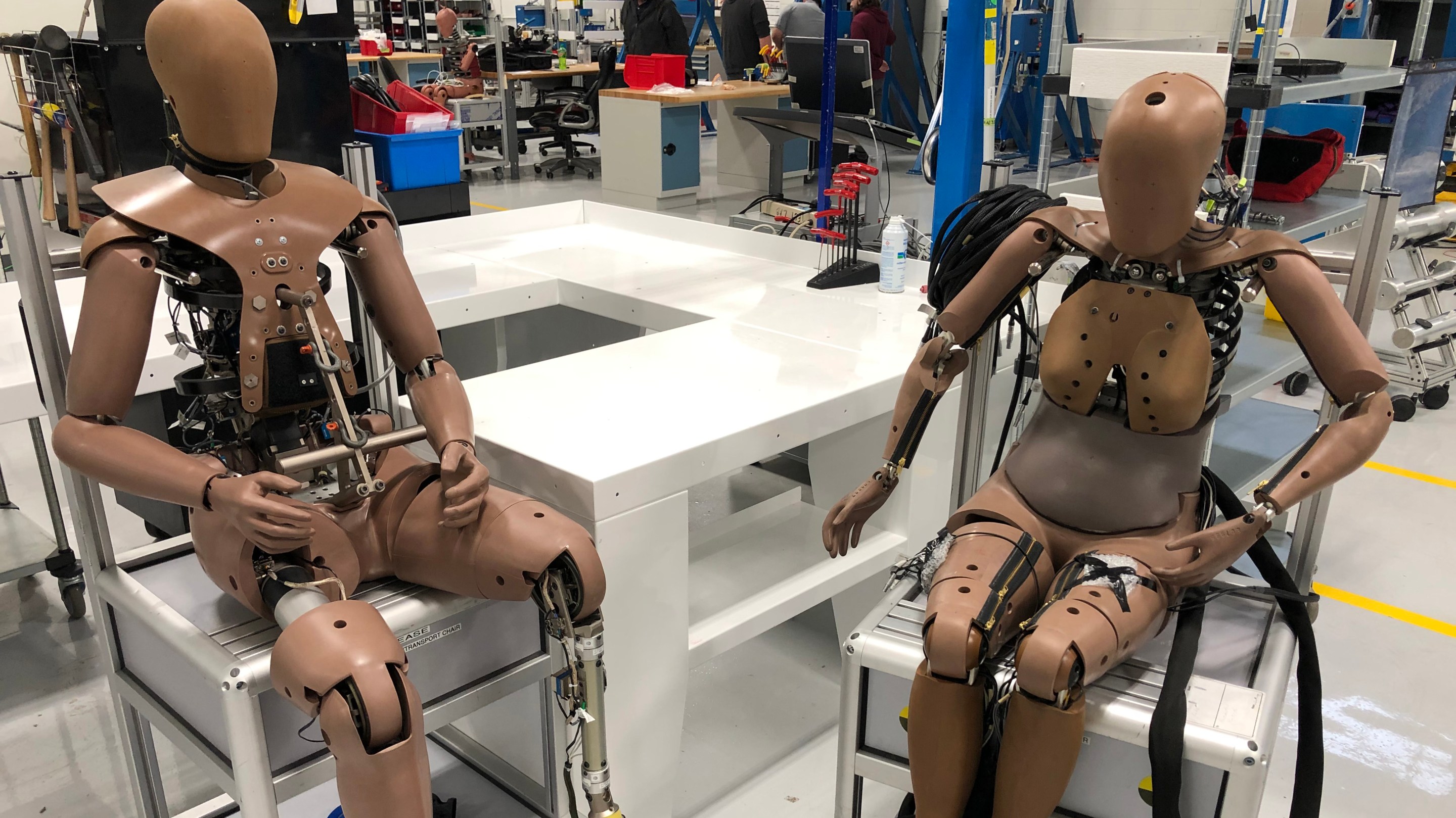It's the dumbest problem with the simplest solution.
Federal automobile crash tests don't use "female" dummies, which helps mak people assigned female at birth about 70 percent more likely to suffer serious leg injuries in car crashes. Instead, the National Highway Traffic Safety Administration uses shorter dummies based off male bodies — and doesn't even put them in the driver seat, even though women make up a majority of American motorists.
Streetsblog spoke recently with 24-year-old Maria Weston Kuhn, the founder and president of Drive US Forward, about her organization's effort to build support for the bipartisan She DRIVES Act, which would require NHTSA use dummies based off women's bodies. Drive US Forward recently launched an online tool for contacting your senators to tell them to get behind the bill. Check it out here.
Kuhn is one of the featured speakers at next month's National Youth Transportation Equity Convening, which is being held on Sept. 20 and 21 in Denver (register online via Eventbrite).
This conversation has been edited for length and clarity.
Maria Weston Kuhn: I'm a car crash survivor. You don't really know about these issues until it impacts you or it impacts your family or your friends. And that was certainly the case with me and my family. I didn't know anything about transportation justice, mobility justice, anything of the sort, until Dec. 26, 2019. My family and I were on Christmas vacation, we were driving down a winding, rainy countryside road, and we came around a corner and an oncoming car [that] had taken that same corner just a little bit too tight struck our family car head-on.
Thankfully we all survived, but my mom and I both had really significant severe injuries. I had to have lifesaving surgery and a stay in the hospital.

When I got home from the hospital I was, of course, on bed rest for a bit. In an effort to help any potential bedrest boredom, my Grandma Jo cut out an article from Consumer Reports and mailed it to me about how because American cars are not safety tested with accurate female crash test dummies, women are 17 percent more likely to be killed and 73 percent more likely to be severely injured than men in the same exact crash.
I remember at the time being really distressed because the injuries that the article described that are most common for women to suffer were exactly what my mom and I had.
As soon as I read that article I knew that I wanted to do everything I could to help. I began researching the issue, writing about it, meeting with other survivors online and doing everything I could to make sure nothing like what happened to us happened to other people.
Streetsblog: I'm so glad you're okay. Tell us a little bit about why crash test dummies have such a seismic effect on the outcomes for people who are assigned female at birth.
Kuhn: The federal New Car Assessment Program is the standard that auto manufacturers design their cars to pass, conducted by NHTSA. Essentially, they run a series of simulated crashes with dummies inside. They hit them against real cars, against real barriers, roll them over and then they take the dummies out and measure what their sensors picked up in those tests.
From that point, they are able to estimate what a person would have experienced, whether it's an injury, fatality and so on — and from there determine the the safety rating from one to five stars. That safety rating is required to be displayed on new vehicles. If you ever go into a new car lot, you might see the "Monroney label" on the window. That one- to five-star safety rating is required to be on there.
That is what auto manufacturers are designing to pass. They're not going beyond it. If there's any kind of inequity or lack of representation in the new car assessment program, cars aren't going to be designed to address that inequity.
NHTSA runs these crash chests without accurate female representation. They use a shrunken-down male dummy that's 4-foot-11' and 108 pounds to represent women. When I say shrunken-down male, I mean the dummy has the internal morphology of a male body — it doesn't have correct female bone mass, bone structure, musculature, fat distribution, organ distribution, anything like that — that all have really serious consequences on how a body reacts to force in a collision.
What that means for car safety is because they have this shrunken-down male dummy representing women, seatbelts, airbags, etc. are not designed to protect us. They only use this miniature male — that's called the Hybrid III-5th. They only use Hybrid III-5ths in the rear and passenger seats for the most fatal crash tests, despite women making up the majority of license drivers in this country. The dummies aren't representative. They're not used properly.
The Hybrid III-5th has inadequate sensors, so all throughout the body there are insufficient sensors, particularly in places that are more likely to be affected by an injury in a crash. The Hybrid III-5th would not have registered the injuries that I suffered — which I think is astounding, because what is the point of having a crash test dummy if it's not picking up the injuries that people are experiencing crashes.
Streetsblog: How would the She DRIVES Act address this? Walk us through this particular bill and the timelines for change that it would lay out.
Kuhn: The SHE DRIVES Act is a bipartisan bill currently before the Senate. It was introduced by Senators Fisher, Murray, Blackburn, and Duckworth and it's currently before the Commerce Committee. The She DRIVES Act, officially the “She Develops Regulations In Vehicle Equality and Safety Act,” is everything we would want in a piece of legislation. It requires that NHTSA adopt the most technologically advanced female crash test dummy into NCAP, and it mandates its use equally as the male dummy, including particularly in the driver's seat.
So that fixes every problem that we just identified, right?

The bill doesn't name a dummy specifically, which I think is really smart, because while there is an advanced female crash system currently working its way through NHTSA approval, this more abstract language allows for continued adoption of improved dummies as the technology gets better.
The most advanced female dummy at this time is called the THOR-5F. It's been in production and development by NHTSA since 2003. It was approved as biofidelic in November 2020, which means that it actually reacts like a woman's body would to force. Unlike the Hybrid III-Fifth, it actually is modeled after the body of people assigned female at birth.
While NHTSA has been developing this dummy for over 20 years, it has been historically reluctant to commit to testing in the New Car Assessment Program — and specifically testing it in the driver's seat. What the She DRIVES Act would do is require that NHTSA incorporate the most technologically advanced female crash test dummy into the New Car Assessment Program.
Streetsblog: Why do you think they haven't done this already?
Kuhn: That's a really great question. I have had the privilege of working directly with the Department of Transportation and NHTSA on a couple of occasions throughout my work. What has been portrayed to me has been that it is essentially about money. What they have said to me is it's just a matter of economics — "How many tests do you want us to run?"
Now, as a crash survivor and a young woman and a young American, that's a really hard reason to rationalize and justify. I think that's probably true for a lot of people who have been involved in crashes, or who have lost loved ones to crashes. What's the point of crash safety testing if you're not actually going to do enough of it?
I have asked NHTSA to come up with a number and they have as of yet been unable to. One of our partner organizations, VERITY NOW, has estimated that any costs incurred by redesigning cars to make them safe for women would cost consumers less than $1 per car. The government already owns eight of these more advanced female crash test dummies. Although those are very expensive — they run about $1 million a piece — eight dummies is sufficient to test for a long time. You don't need more than that.
Car crashes in America cost billions and billions of dollars a year, particularly crashes that just involved woman. Car crashes in which women are killed cost billions of dollars a year. I have a really hard time understanding why our government safety organizations are not willing to pay that price.

Streetsblog: Why is it important for young people like you to be leading on this?
Kuhn: I get that question a lot, you know, "Why Gen Z?" Because it's not on the surface, maybe, a particularly youth-centric issue. But if you look into it, road traffic injuries are the number two killer of young people in America — number one until just recently. Globally, road traffic injuries are the number one killer of young people. It's our bodies that are on the line.
I have found that people in our age group are less likely to be OK with existing in these institutions that don't prioritize our safety. I started Drive US Forward as a Gen Z organization because I wanted the people who the issue matters to most to have the loudest voices. Young voices have been historically excluded from the transportation justice conversation, and I think that the people who are facing the brunt of the impact should be among the ones to be able to change it.
The National Youth Transportation Equity Convening is happening on Sept. 20 and 21 in Denver. Register online here.






